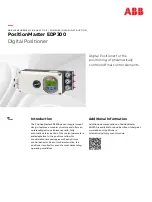
4
The valve is supplied from the factory pre-set at 50 psig. To increase the pressure setting, back off
the lock nut located beneath the colour coded bonnet cap. Turn the Allan bolt
using a 5/16” or #8
hex key clockwise to increase pressure setting or counter clockwise to reduce pressure setting.
Approximately one (1) full turn of the handle is equal to 10 psig.
If maintenance is required on the valve:
1. Ensure that the valve is
properly isolated
from the line,
not under pressure
and
properly
flushed
of chemical before proceeding to disassembly.
2. Turn Allan bolt on the top of valve, counterclockwise until all spring pressure is released
before
proceeding to undo retaining nuts, to remove top of valve for diaphragm
replacement.
3. All working components ie. diaphragm, spring can be accessed by removing the four
retaining bolts located on the bottom of the valve (item # 9 of parts breakdown).
Use a 3/16”
Allan key or #5 hex key to remove the retaining bolts.
4. When replacing a PTFE coated diaphragm, ensure the PTFE coated side of the diaphragm
is facing down when viewed from the top of the valve. The installed diaphragm also
functions as the body seal. (Torque nuts to 40 inch pounds when reassembling)
Installation and Maintenance of Pressure Relief Valves:
Pressure relief valves are installed on the discharge line of a pump and should be located as close
as possible to the metering pump. The valve is of a two port design and is required to be installed
on a branch tee for piping back to the supply tank or feed side of the pump.
Never install shut-off/isolation valves between pump discharge and in-line pressure relief valves.
When using in conjunction with a back pressure control valve, always install back pressure valve
downstream of pressure relief valve. The relief port on the pressure relief valve should be piped
back to the feed tank or suction side of the pump (see typical installation schematics).
Caution: The plastic valve bodies have standard threads, which are tapered.
When installing pipe into the body, hand tighten only to avoid cracking
.
Gauge Installation Instructions:
For the convenience of pressure setting and reading, there are two ports provided one on either
side of the valve body. These ports are normally not drilled or tapped unless initially ordered that
way. To drill and tap the ports it is recommended that you first disassembly the valve so as to not
leave any foreign particles in the valve
. You will require a 1/8” or 3.264 mm drill bit to drill out the
centre point of the gauge port opening into the body of the valve. The port is already the correct
diameter
for the tapping of a ¼” or M10 thread. It is recommended that you use a
regular tap then
a bottoming tap to open the port up, this will allow for the proper number of gauge threads.
Summary of Contents for ECO-25
Page 10: ...10 ...
Page 12: ...12 Notes ...



















